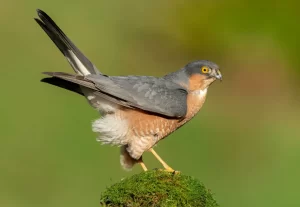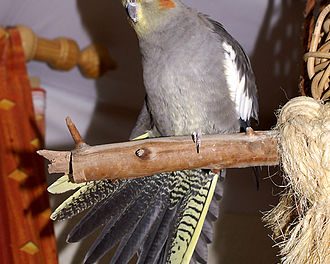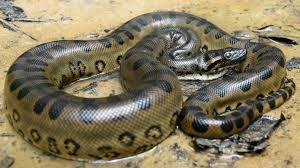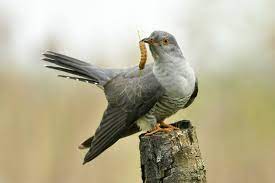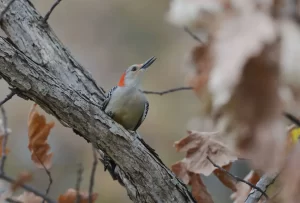The Eurasian sparrowhawk is a small bird of prey with short, broad wings and a long tail, both adaptations to maneuvering through trees. Adult males have bluish-grey upperparts and orange-barred underparts; females and juveniles are brown above with brown barring below.
These birds have a small bill used for plucking feathers and pulling prey apart, rather than killing or cutting. Their long legs and toes are an adaptation for catching and eating birds. Though they are predators which specialize in catching woodland birds, Eurasian sparrowhawks can be found in any habitat and often hunt garden birds in towns and cities.

Eurasian sparrowhawk
In this article, you will learn about the most common things of The Eurasian sparrowhawk with Pritish Kumar.
Distribution
Eurasian sparrowhawks are widespread throughout Europe, Asia, and Africa. Birds from colder regions of northern Europe and Asia migrate south for the winter, some to North Africa (some as far as equatorial east Africa) and India; members of the southern populations are resident or disperse.

Range of Eurasian sparrowhawk
Eurasian sparrowhawks can be found in most woodland types in their range, and also in more open country with scattered trees. They can also be seen in gardens and in urban areas and will even breed in city parks if they have a certain density of tall trees.
Description
The Eurasian sparrowhawk is a small bird of prey with short, broad wings and a long tail, both adaptations to manoeuvring through trees. Females can be up to 25% larger than males and weigh up to twice as much. Marked size difference in this direction is unusual in higher vertebrates but typical in birds of prey and most marked in birds of prey which hunt birds.
The adult male is 29–34 cm (11–13 in) long, with a wingspan of 59–64 cm (23–25 in) and a mass of 110–196 g (3.9–6.9 oz). He has slate-grey upperparts (sometimes tending to bluish), with finely red-barred underparts, which can look plain orange from a distance; his irides are orange-yellow or orange-red.

Eurasian sparrowhawk – Description
The female is much larger at 35–41 cm (14–16 in) long, with a wingspan of 67–80 cm (26–31 in), and a mass of 185–342 g (6.5–12.1 oz). She has dark brown or greyish-brown upperparts, and brown-barred underparts, and bright yellow to orange irides. The juvenile is warm brown above, with rusty fringes to the upperparts; and coarsely barred or spotted brown below, with pale yellow eyes; its throat has dark streaks and lacks a mesial (midline) stripe.
The Eurasian sparrowhawk’s pale underparts and darker upperparts are an example of countershading, which helps to break up the bird’s outline. Countershading is exhibited by birds of prey which hunt birds and other fast-moving animals. The horizontal barring seen on adult Eurasian sparrowhawks is typical of woodland-dwelling predatory birds, while the adult male’s bluish colour is also seen in other bird-eating raptors, including the peregrine falcon, the merlin and other Accipiters.
Habits and Lifestyle
Eurasian sparrowhawks live singly or in pairs. They are active during the day spending most of their time hunting. These birds hunt by surprise attack, using hedges, tree belts, copses, orchards, and other covers near woodland areas. They wait, hidden, for woodland birds to come near, then break cover and fly out fast and low. A chase may follow, with the hawk even flipping upside-down to grab the victim from below or following it on foot through vegetation.
It can “stoop” onto prey from a great height. During hunting, Eurasian sparrowhawks can fly 2-3 km (1.2-1.9 mi) per day. They rise above tree level mostly to display, soar above territory, and make longer journeys. The flight of these birds is a characteristic “flap-flap-glide”, with the glide creating an undulating pattern.
Diet and Nutrition
Eurasian sparrowhawks are carnivores that mainly prey on smaller woodland birds. Males tend to take tits, finches, sparrows, and buntings while females often take thrushes and starlings but are capable of killing birds weighing 500 g (18 oz) or more. They also hunt rodents, small mammals, and insects.

Eurasian sparrowhawk – diet
Mating Habits
Eurasian sparrowhawks are monogamous and form pairs. Most birds stay on the same territory for one breeding season, though others may keep the same one for up to eight years. Eurasian sparrowhawks locate their nests in the fork of a tree, often near the trunk and where two or three branches begin, on a horizontal branch in the lower canopy, or near the top of a tall shrub.
If available, conifers are preferred. A new nest is built every year, generally close to the nest of the previous year, and the male does most of the work. The structure, made of loose twigs up to 60 cm (2.0 ft) long, has an average diameter of 60 cm (24 in). When the eggs are laid, a lining of fine twigs or bark chippings is added. The female usually lays a clutch of 4 or 5 pale blue with brown spots eggs.

Eurasian sparrowhawk – newborn
The altricial, downy chicks hatch after 33 days of incubation. After hatching, the female cares for and feeds the chicks for the first 8-14 days of life, and also during bad weather after that. By 24-28 days after hatching, the young birds start to perch on branches near the nest and take their first flight.
They are fed by their parents for a further 28-30 days, staying close to the nest while growing and practicing flying. At this stage, they are extremely vocal, and their cries to their parents can often be heard a considerable distance away. The young hawks disperse after their parents stop providing them food. Reproductive maturity is reached between 1 and 3 years of age.
Population
Population threats
Eurasian sparrowhawks are not considered endangered at present. However, this species has suffered high persecution by hunters and falconers. The Eurasian sparrowhawk’s hunting behavior has brought it into conflict with humans for hundreds of years, particularly racing pigeon owners and people rearing poultry and gamebirds.
It has also been blamed for decreases in passerine populations. Falconers have used Eurasian sparrowhawks since at least the 16th century; although these birds have a reputation for being difficult to train, they are also praised for their courage. Eurasian sparrowhawks also suffer from habitat loss and declines in prey availability.

Eurasian sparrowhawk – in nest
Population number
According to the IUCN Red List, the total population size of the Eurasian sparrowhawk is 2,000,000 to 3,200,000 mature individuals. The European population consists of 364,000-571,000 pairs, which equates to 728,000-1,150,000 mature individuals. Currently, this species is classified as Least Concern (LC) on the IUCN Red List and its numbers today are stable.
Ecological niche
Eurasian sparrowhawks feed on a wide range of small birds and mammals and thus help control the populations of their prey species. During one year, a pair of Eurasian sparrowhawks could take 2,200 house sparrows, 600 common blackbirds, or 110 wood pigeons.
Reference
https://animalia.bio/eurasian-sparrowhawk?environment=331

